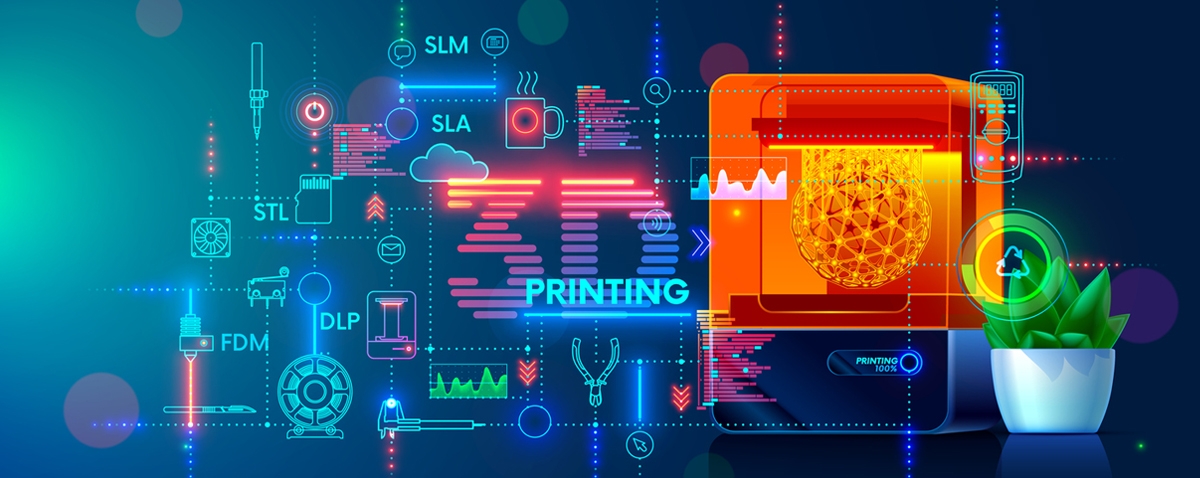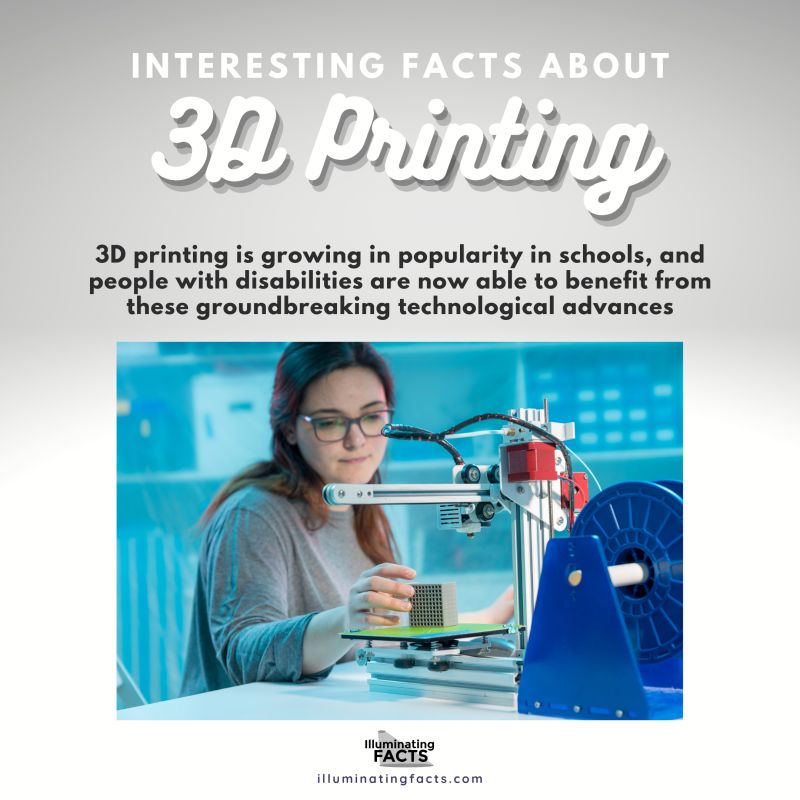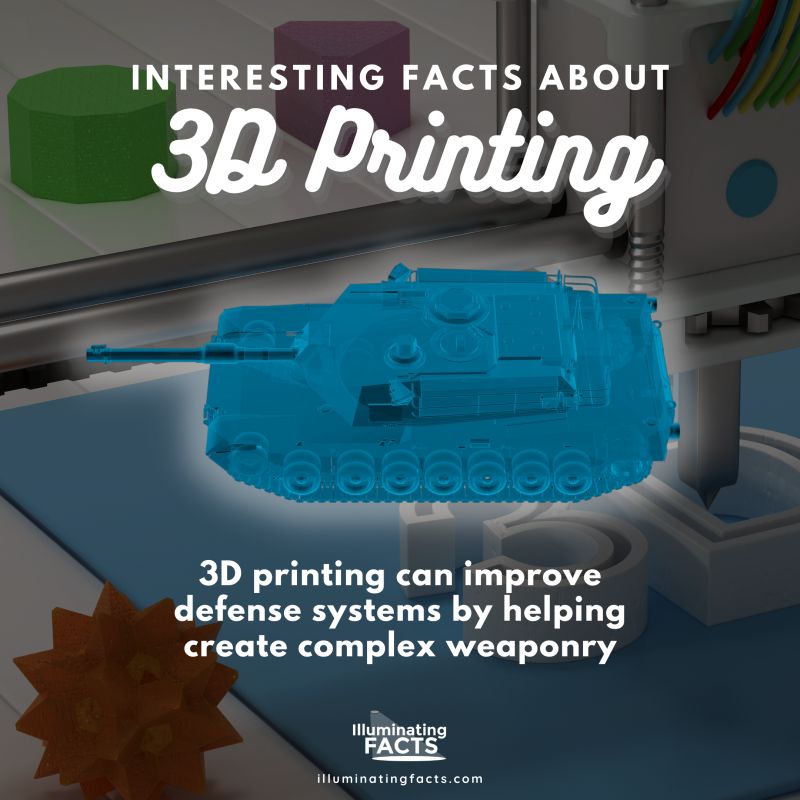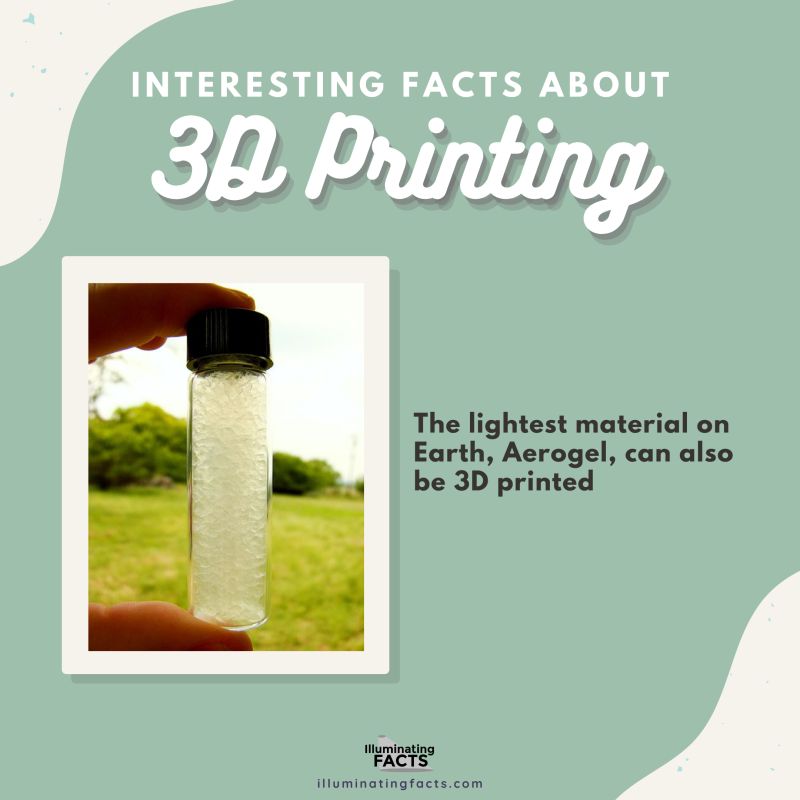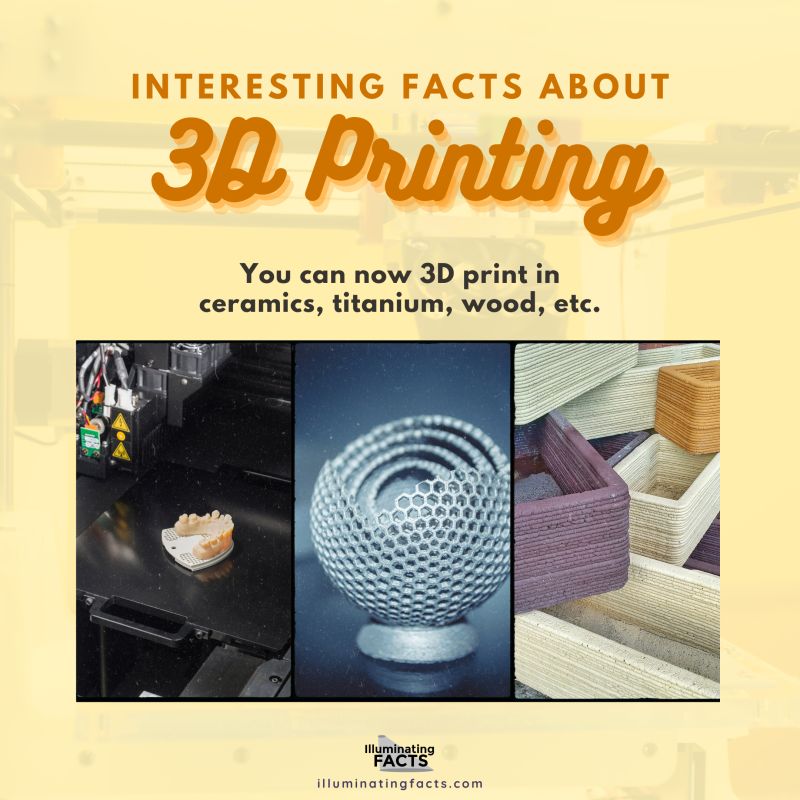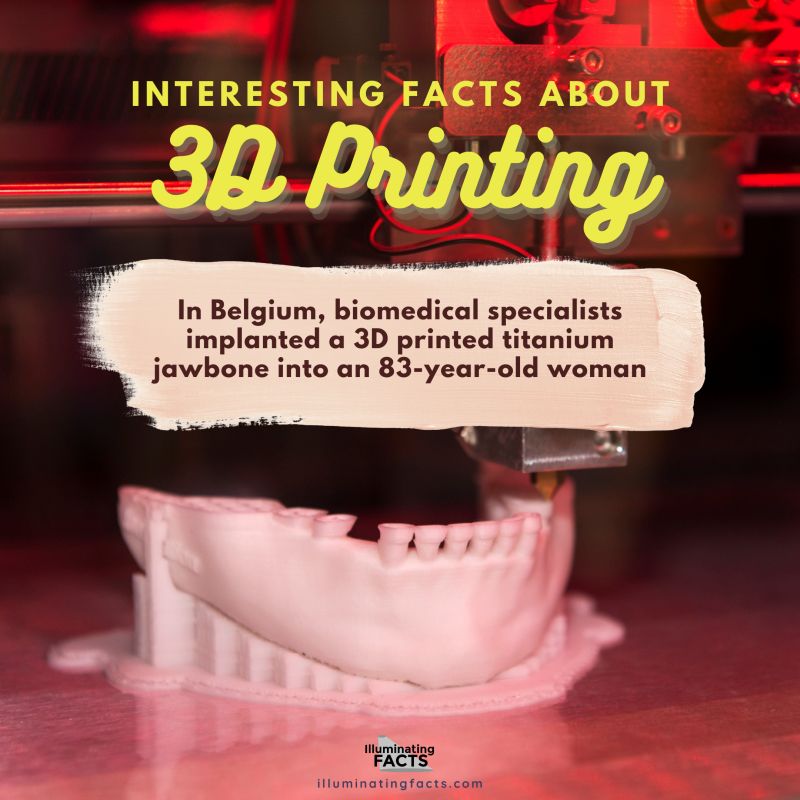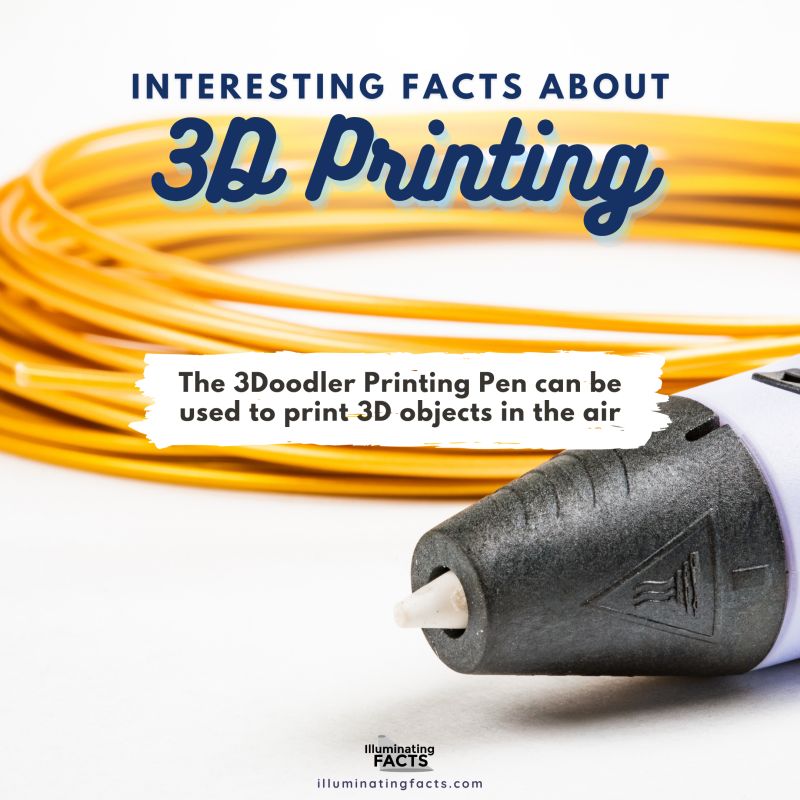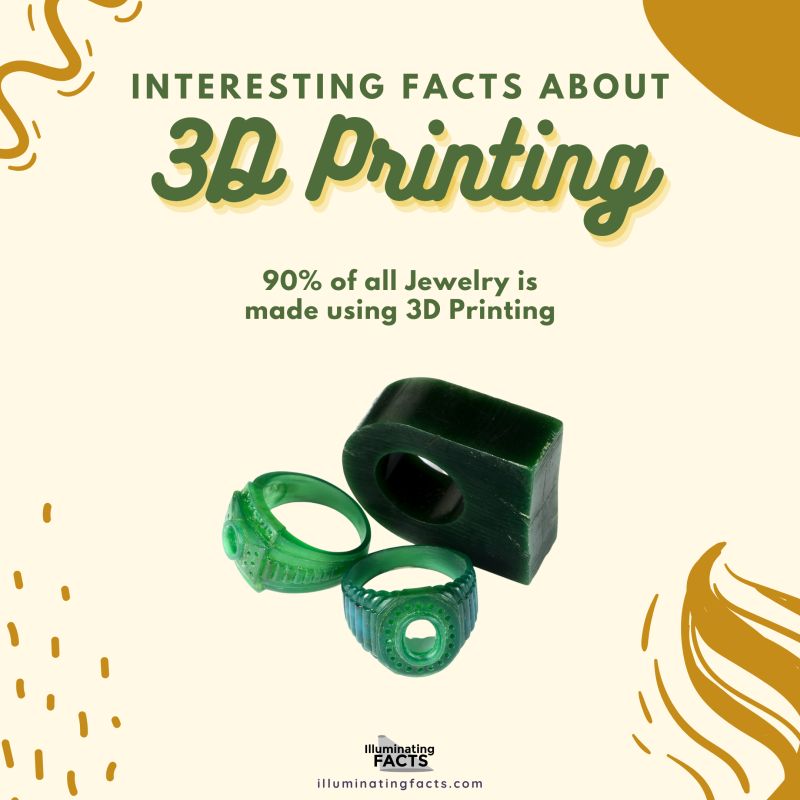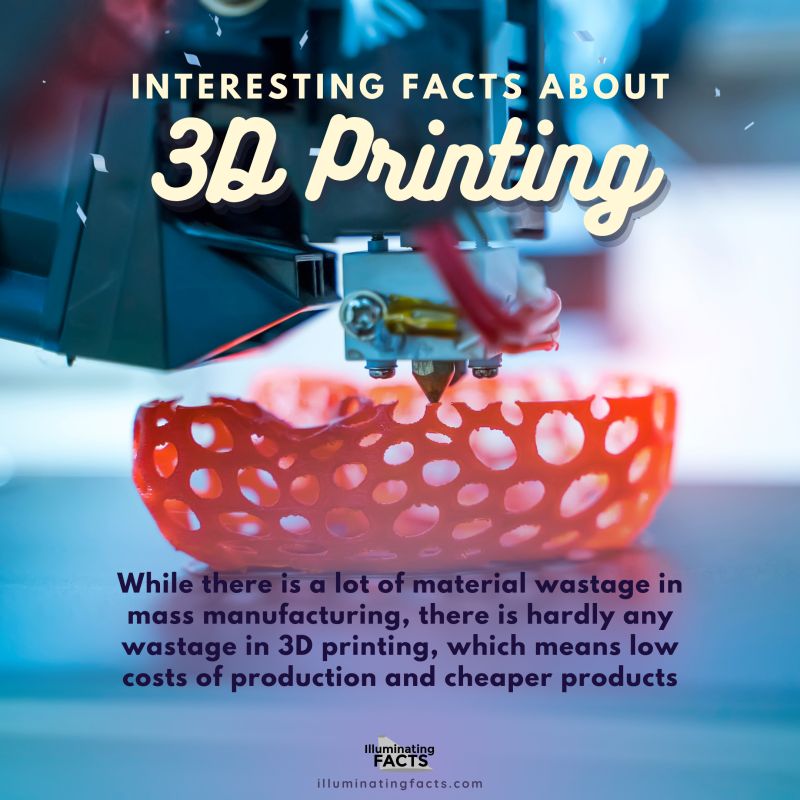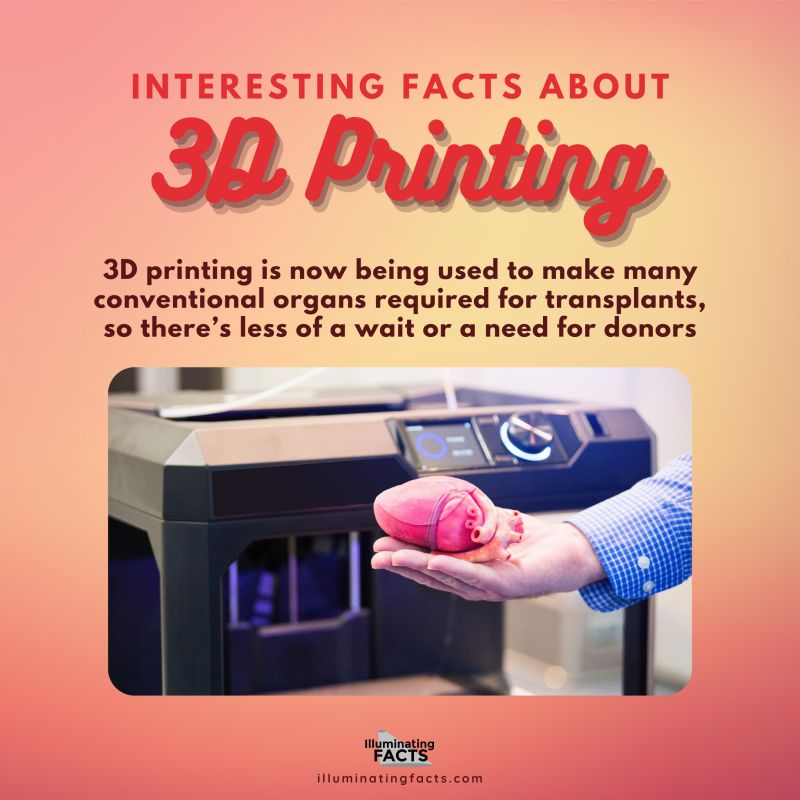Every year tons of innovations are made in the 3D printing industry, but there is something that stays the same – hype. The latest developments and designs just get crazy internet exposure. We decided to put together a list of some awesome facts about 3D Printing. Let’s check them out.
1. A 3D printer builds objects by adding layer upon layer until it has a complete product
Well, here’s the gist: A 3D printer uses a series of computer-controlled motors and moving platforms to create a three-dimensional object by stacking thin layers of plastic or another material on top of each other. Imagine this process repeatedly happening, as the printer adds layer after layer until the object is complete.
2. 3D printing was originally used for prototyping but is now being used for production-ready pieces
The first 3D printers were large machines that made full-sized, three-dimensional plastic objects. Corporations used them to make prototypes of products, which helped them save millions of dollars on product testing. Ford, for instance, makes many car parts using 3D printing, so it doesn’t have to build expensive models of its cars and trucks for prototyping. Ford estimates that it could save $493,000 a month if it used 3D printing for parts testing [1]
3. Scientists at NASA are thinking about sending robots to the moon with the ability to construct 3D printed buildings and roads
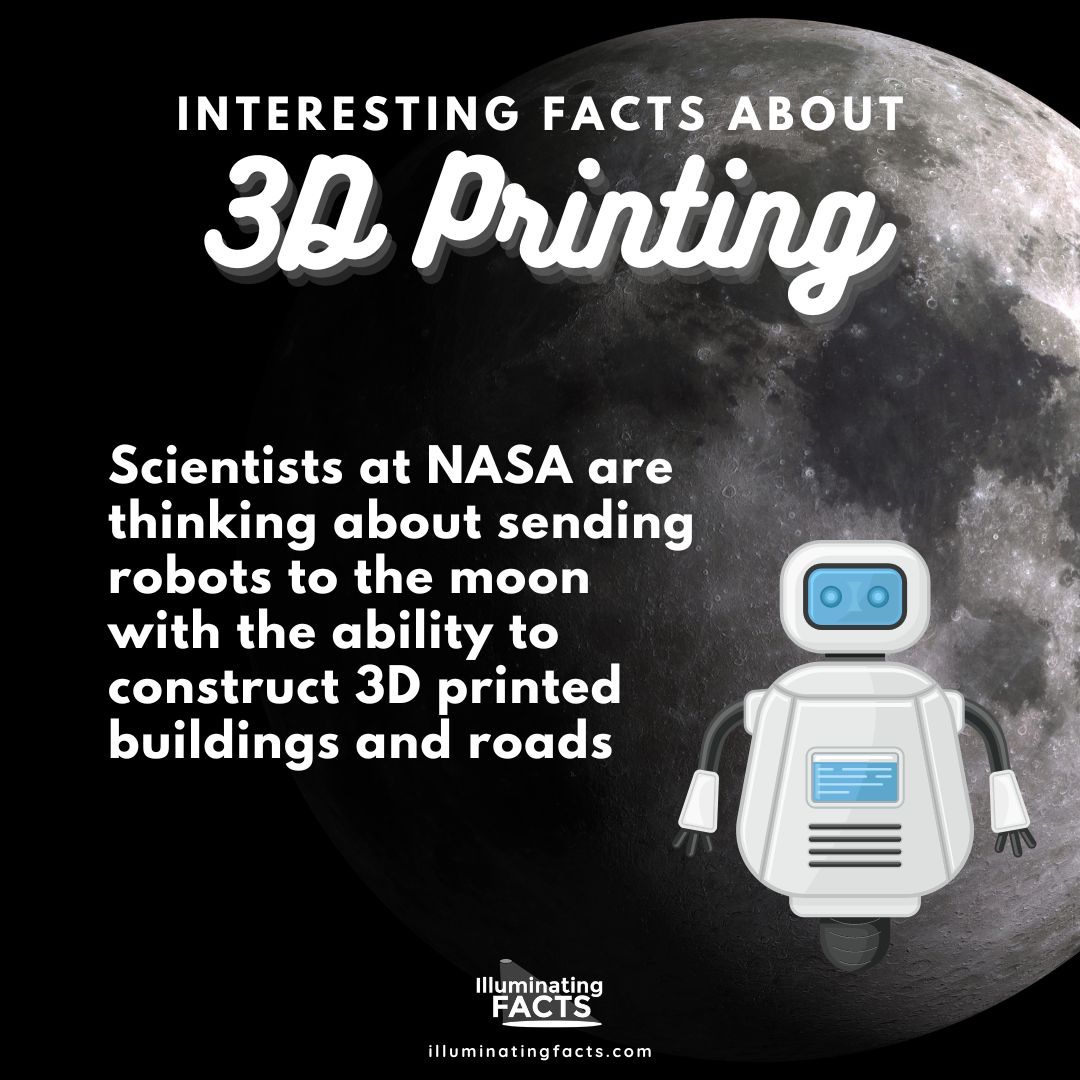
NASA researchers were inspired by the 2014 3D-printed Habitat Challenge and are currently using 3D printers to create building blocks for structures in space. The winning team designed a long, vertical structure using 3D printing techniques and a mix of bioplastic and the Martian soil. These structures would provide astronauts with more comfortable living quarters on the moon and Mars. [2]
If successful, the project will lead to future missions where astronauts will be able to construct buildings and infrastructure instead of relying entirely on supplies sent from Earth.
4. 3D printing is growing in popularity in schools, and people with disabilities are now able to benefit from these ground-breaking technological advances
It’s true! It can be used to teach students about engineering and computer-assisted design. It also allows all students (not just the ones who have access to technology in their homes) an opportunity to experiment with 3D modeling.
In fact, students with disabilities are using 3D printing to make prosthetic limbs, orthotics, and other devices that help them accomplish everyday tasks. Students with disabilities are using technology to create their own prosthetics and assistive devices. [3]
5. 3D Printing as a concept is older than the internet
The concept of 3D printing has been around since 1945 and was in its primitive form in 1971. This means that in theory the technology has been around for 80 years and for 40 years in practice, which is way before the internet became widely available. The 3D-printing craze really took off in 2010 when companies came up with innovative ways to build objects.
3D printing was developed in the 1980s in Japan and is even older than the internet. In fact, it’s pretty old—it was invented by Chuck Hull, who also co-founded 3D Systems, the company that patented stereolithography. [4]
6. Another first from NASA—a 3D-printed pizza
Now that robots have become more intelligent, a Silicon Valley startup BeeHex has developed a special 3D printer to print pizza. NASA funded this invention because it wanted astronauts to be able to choose and craft their own meals on missions. Also, they want to keep astronauts from chowing down on freeze-dried space food during long-duration missions. [5]
7. 3D Printing can improve defense systems by helping create complex weaponry
If you have a blueprint and access to the right machine—which anyone can buy at their local hardware store—you could build a gun in your living room. And that’s not all. Researchers are concerned that advances in artificial intelligence and 3D printing might soon allow people to create weapons of mass destruction on demand, right in the comfort of their own homes. [6]
8. The lightest material on Earth can also be 3D printed
Did you know that the lightest material on Earth is a 3D-printable substance called Graphene Aerogel, which was created by Chinese scientists and is 7 times lighter than air? It’s a material that is 99.8% air, and the remaining 0.2% is solid, but it’s still strong enough to be used in everything from insulation to medical devices. The material received official recognition from Guinness World Records in 2019 as the lightest material that weighs only half a milligrams per cubic centimeter. [7]
9. You can 3D print in ceramics, titanium, wood, etc.
3D printing has moved beyond just plastic and metal, with the latest development being 3D printing in ceramics, wood, titanium, and more. Ceramics have always been a challenge to work with, but with 3D printing, the possibilities are endless. [9]
10. NASA is planning on using lunar dust to as a 3D Printing material
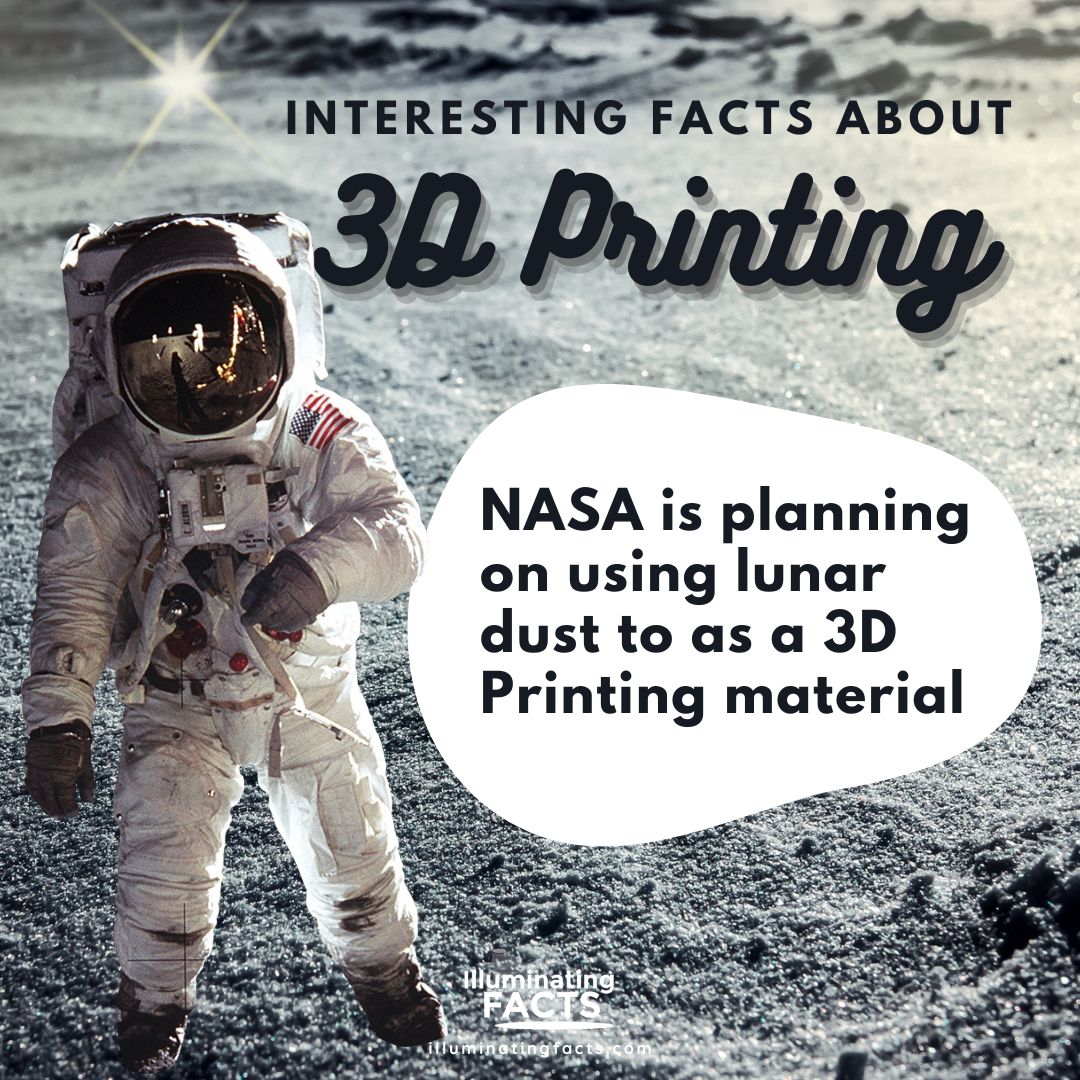
Mostly, 3D printers use filament and resin to create tiny things like replacement parts, toys, and doodads. However, according to National Aeronautics and Space Administration (NASA) officials, the agency wants to replace these with moon rocks.
Recently, a spaceship docked with the International Space Station delivered a 3D printer that can use lunar dust to make solid materials. [10]
11. In Belgium, biomedical specialists implanted a 3D printed titanium jawbone into an 83-year-old woman
What happens when engineers and doctors team up? Doctors and engineers have been working together to create the world’s first lower jaw transplant using a prosthetic jaw made on a 3D printer (weighed only 107 grams). After an 83-year-old Belgian woman suffered from an infection that started quickly eating her jaw, , she underwent the operation in June 2012.
Researchers at the University of Hasselt BIOMED Research Institute in Belgium have helped design a custom-made titanium implant by first producing a 3D model and printing it out in just a couple of hours! [11]
12. The Photonic professional GT is a 3D printer that can create micro and nano-objects of widths as small as a human hair
In 2012, a group of scientists at the Vienna University of Technology in Austria used a special 3D printing technique to build an F1 race car and a cathedral that is smaller than dust mites. It only took about 4 minutes. A firm called Nanoscribe GmbH—which emerged from the Karlsruhe Institute of Technology in Germany—has developed a 3D printer called the Photonic Professional GT. Maybe you’ve heard of it. It can produce detailed structures on a similar scale but faster than any other 3D printer.
Interestingly, it took the 3D printer less than 50 seconds to create a spaceship (from the Wing Commander line of video games) that measures as wide as human hair. [12]
13. The 3Doodler printing pen can be used to print 3D objects in the air
In 2013, a toy company called WobbleWorks launched a project on Kickstarter to fund the world’s first 3D printing pen. The project raised $2.3m (£1.5m).
The 3Doodler is like a handheld 3D printer that lets you draw in the air, and your creations come to life as three-dimensional structures. The original 3Doodler required no software or wires, and the new one works in the same way. But it’s smaller and lighter than the original model. [13]
14. 90% of all jewelry is made using 3D printing
Did you know that 90% of all jewelry pieces are made using 3D printing? Just like hearing aids, the jewelry industry was one of the first industries to see the potential for 3D services and start using them to make their work more efficient. Jewelry makers now use 3D printing to make molds for casting jewelry at a faster pace than the traditional method of using bare hands. 3D printing also allows printing complex designs, which was not possible in the past using traditional techniques. [14]
15. There is Hardly any wastage in 3D printing
3D printing uses much less material than other technologies and can create far more intricate objects.
Imagine a really tiny version of your house. Now think about the number of materials it takes to build even the smallest part of that house. 3D printing requires only the materials required to build the part itself and no more because there is no need to cut materials from large chunks. [15]
16. 3D printers are often used to create props in movie productions
In an interview, Leandre Lagrange—a 3D concept artist who worked on the movie Alien: Covenant—explained how he developed a whole character design using ZBrush. Although using computer-generated imagery (CGI) was once the cheapest way to make a movie look extraordinary, filmmakers have now realized that they can’t beat using real objects, realistic costumes, and real accessories onscreen.
The Demogorgon, a creature on the Netflix show Stranger Things, has been conjured into reality by a film production company called Aaron Sims Creative. The filmmakers used 3D printing to recreate the digital design of the Demogorgon. In addition, 3D scans of prehistoric skeletons and fossils were used to create 3D-printable models for the blockbuster movie Jurassic World. [16]
17. 3D printing is now being used to make many conventional
People all around the world are in desperate need of organs. For example, in the United Kingdom, you can expect to wait almost two and a half years for a kidney transplant on the National Health Service. The same goes for the liver, lungs, and other organs. This is because there is an ongoing shortage of organs available for lifesaving transplants.
One of the leading causes of death in the US includes lack or unavailability of transplant tissues and organs. Over 900,000 deaths a year could be prevented or delayed by organ or engineered tissue transplants.
Researchers and companies are racing to create body parts that can be printed on a 3D printer. The San Diego Company Organovo has been printing parts of lungs, kidneys, and hearts since 2007. [17]
18. Model Dita Von Teese became the first star to put on a 3D printed dress made of 3,000 parts
Francis Bitonti and Michael Schmidt design studios a 3D-printed dress to be worn by burlesque dancer Dita Von Teese. The gown, which was designed by Schmidt and printed using a laser-based technology called selective laser sintering (SLS), is made from nylon powder. The plastic is fused together layer by layer by the 3D printe. [18]
19. You can 3D Print a Functional Diffraction Grating
The optical diffraction of a CD—its rainbow-like effect that splits light into its component colors—can be achieved in many ways. One of those is by creating a diffracting surface. The surface of an object printed with 3D printing technology can be as smooth and shiny as the surface it was printed on.
One way to achieve this surface is through “diffraction gratings,” tiny grooves that reflect light in such a way as to create a glossy effect. [19]
20. A 3D printer can transform any home into a factory
This technology has huge implications for both consumer and industry products. Consumers can now make anything they want in their own home, including items that previously would have taken an entire factory to produce, such as violins. On the industrial side of things, companies like Amazon are using 3D printers to make drone parts. [20]
Conclusion
3D printing is a very active, dynamic area today – and arguably one of the greatest technological innovations of the past century. It’s likely that we have only just scratched the surface of its potential, however, so there are bound to be more interesting facts discovered in the years to come. For now, though, let these interesting 3D printing facts be a window into this exciting world.
References
- (2019, August 25). 3D printing started in the ‘80s. Medium. https://medium.com/@felix_9915/3d-printing-started-in-the-80s-e80014f75730
- Who won NASA’s 3D printed habitat challenge on Mars?(2019, May 29). 3D Printing Blog: Tutorials, News, Trends and Resources | Sculpteo. https://www.sculpteo.com/blog/2019/05/29/nasas-3d-printed-habitat-challenge-the-winners-were-announced
- Global 3D printing | 3D printing services – Some unique and interesting facts to share | ON demand 3D printing. (n.d.). Global 3D Printing | ON demand 3D printing. https://global3d.com.au/news-item/3d-printing-services-some-unique-and-interesting-facts-to-share/a75dd437-e92b-a548-7038-5cbfb49c0120
- History of 3D printing: It’s older than you think. (2022, June 8). Redshift – English. https://redshift.autodesk.com/articles/history-of-3d-printing
- Gohd, C. (2017, March 7). NASA astronauts can No. 3D-Print pizzas in space. Futurism. https://futurism.com/nasa-astronauts-can-now-3d-print-pizzas-in-space
- Gault, M. (2019, September 10). 3-D printers could help spread weapons of mass destruction. Scientific American. https://www.scientificamerican.com/article/3-d-printers-could-help-spread-weapons-of-mass-destruction/
- Graphene Aerogel is 99.8% air, as strong as steel, and the world’s lightest material — Pheneovate Graphene innovation. (2020, June 6). Pheneovate Graphene Innovation. https://www.pheneovate.com/news-notes/2018/6/10/graphene-aerogel
- org » Part 1: Samuel Kistler, inventor of Aerogel. (n.d.). Aerogel.org. https://www.aerogel.org/?p=464
- Zhangwei Chen ZiyongLi Junjie Li Chengbo Liu Changshi Lao Yuelong Fu Changyong Liu Yang Li Pei WangYi He. (2019). 3D printing of ceramics: A review. Journal of the European Ceramic Society, 39, 661-687. https://www.sciencedirect.com/science/article/pii/S0955221918306782
- chaudhry. (2021, August 18). NASA tests 3D printer which uses moon dust as construction material. Asianet News Network Pvt Ltd. https://newsable.asianetnews.com/science/nasa-tests-3d-printer-uses-moon-dust-as-construction-material-gcw-qy0xsk
- Woman gets world’s first 3D printed jaw transplant. (2012, February 6). CBS News – Breaking news, 24/7 live streaming news & top stories. https://www.cbsnews.com/news/woman-gets-worlds-first-3d-printed-jaw-transplant
- Hill, D. J. (2017, May 31). A 3D printed spaceship on the scale of a human hair? Hello Nanoscribe 3D printer. Singularity Hub. https://singularityhub.com/2013/03/17/a-3d-printed-spaceship-on-the-scale-of-a-human-hair-hello-nanoscribe-3d-printer/
- 3Doodler 2.0 printing pen makes drawing in air a reality. (2015, January 6). the Guardian. https://www.theguardian.com/technology/2015/jan/06/3doodler-20-printing-pen-drawing-in-air-wobbleworks
- Global 3D printing | The unique facts on 3D services that no one told you about | ON demand 3D printing. (n.d.). Global 3D Printing | ON demand 3D printing. https://global3d.com.au/news-item/the-unique-facts-on-3d-services-that-no-one-told-you-about/d73692d9-0472-6e57-6673-5cbfb52ef95e
- What are the advantages and disadvantages of 3D printing?(n.d.). Joining Innovation with Expertise – TWI. https://www.twi-global.com/technical-knowledge/faqs/what-is-3d-printing/pros-and-cons
- How does the film industry use 3D printing?(2018, May 25). 3D Printing Blog: Tutorials, News, Trends and Resources | Sculpteo. https://www.sculpteo.com/blog/2018/05/25/how-does-the-film-industry-use-3d-printing/
- Could 3D printing solve the organ transplant shortage?(2017, July 30). the Guardian. https://www.theguardian.com/technology/2017/jul/30/will-3d-printing-solve-the-organ-transplant-shortage
- 3D-printed dress for dita von Teese. (2014, March 10). Dezeen. https://www.dezeen.com/2013/03/07/3d-printed-dress-dita-von-teese-michael-schmidt-francis-bitonti/
- How to 3D Print a Functional Diffraction Grating. (2020, February 5). All3DP. https://all3dp.com/2/3d-print-a-functional-diffraction-grating
- Tovar, I. (2020, July 10). Amazon reveals top secret 3D printed drone lab in Cambridge UK. 3D Printing Industry. https://3dprintingindustry.com/news/amazon-reveals-top-secret-3d-printed-drone-lab-cambridge-uk-96975

